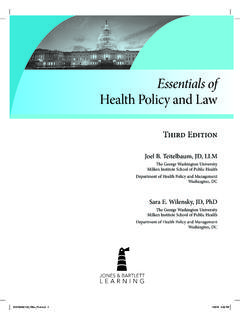Transcription of Hospitals and the Affordable Care Act (ACA) - jhsph.edu
1 Hospitals and the Affordable care Act (ACA) General Housekeeping If you experience any technical difficulties during the webinar, please contact Corporate Account Customer Support at: 1-888-259-8414 or 1-805-617-7002 About Us Exploration and Intervention for Health Designated a National Center of Excellence by the National Institutes of Health, National Institute on Minority Health and Health Disparities Andrea Thompson Michael Thompson Hospitals and the Affordable care Act (ACA) 5 Discussion Points Define the Affordable care Act (ACA) Describe main changes since the ACA went into effect Describe how the ACA may affect Hospitals and your work as a healthcare provider Answer your questions 6 The Signing of ACA (OBAMACARE) March 2010 7 Affordable care Act : The Purpose 1.
2 Make health insurance available to more people 2. Make health insurance more Affordable 3. Make health insurance easier to understand 8 Key Activities to Date q Individual Mandate q Young Adult Coverage q No Pre-Existing Conditions q No Lifetime Limits q Medicaid Expansion q The Healthcare Insurance Marketplace 2012 2011 2010 2013 9 Individual Mandate (Shared Responsibility) Starting in 2014, you MUST have health coverage or pay a penalty. Accepted forms of coverage: q Public insurance q Employer-sponsored insurance q An individual policy q A policy through the Marketplace You may have to pay a fee with your tax return (Starting when you file your 2014 tax return in 2015) 10 What is the penalty ? Year Flat Dollar Amount Percentage of Household Income 2014 $95 1% 2015 $325 2% 2016 $695 You pay the higher amount between flat dollar amount and the percentage.
3 The penalty for minors is half the amount of adults 11 Young Adult Coverage A child under age 26, can stay on his or her parent s health plan. This applies even if the child is: Married Living outside the family home Financially independent Have coverage offered at work 12 Pre-Existing Conditions If you have a pre-existing condition, you cannot be denied health insurance q If you under 19 today, you cannot be denied q As of Jan 1, 2014, no one can be denied 13 No Lifetime Limits Insurance companies cannot stop paying for essential health benefit services simply because your claims are high. Essential health benefits are a set of health care service categories that must be covered by plans in the Marketplace (examples: ER and Maternity) 14 What if you can t afford insurance ?
4 Depending on your income, you may be able to get help in the form of: 1. Discounts (credits) against your premium or 2. Help with out-of-pocket costs in your plan (cost sharing). Income must fall between 100% and 400% of the federal poverty level. For example, that s $11,490 and $45,960 per year for an Individual 15 Medicaid Expansion As part of the Supreme Court ruling on the ACA, each state had the option to expand Medicaid. Perceived Benefits of expansion: q Close the coverage gap of people who make too much to qualify for Medicaid but too little to buy private insurance q Shift 100% of costs from State to Federal government, from 2014 to 2017 90% thereafter 16 Medicaid Expansion continued.. Current breakdown of states with and without Medicaid expansion.
5 1. Number of states expanding: 26 2. Number of states not expanding: 25 17 Medicaid Expansion continued.. (Kaiser Family Foundation 2013) 18 Two other changes .. 19 What Happens To Medicare? Medicare coverage is protected More preventive services Save money on brand-name drugs Donut hole will be closed by 2020 20 What about COBRA in 2014 ? Under the ACA, individuals will have the option to avoid COBRA and purchase private insurance through the Marketplace 21 The Health Insurance Marketplace 22 When can you enroll in the Marketplace ? Marketplace Initial Open Enrollment : Started October 1, 2013 and ends March 31, 2014 Annual Open Enrollment periods after that start on October 15 and end on December 7 Special Enrollment Periods available only under certain conditions during the year 23 Marketplace Types The are three types of Marketplaces: 1.
6 Federally Facilitated Marketplace (FFM) run entirely by the federal government (NJ and PA, under ) 2. Partnership run primarily by state with assistance from the federal government (DE called Choose Health ) 3. State run entirely by the state (MD called Maryland Health Connection ) 24 Four Main Plan Levels Tiers serve two main purposes: q To create standardized levels of insurance for individuals and small businesses q To serve as benchmarks for premium credits and cost-sharing subsidies Tier Paid by the plan Paid by the insured Bronze 60% 40% Silver 70% 30% Gold 80% 20% Pla=num 90% 10% Catastrophic coverage 25 Essential Health Benefits Qualified Health Plans cover Essential Health Benefits, which include at least these 10 categories 26 Free Preventive Services You won t be charged for services that are defined as Preventive - examples include.
7 Q Blood pressure screening q Cervical cancer screening q Obesity screening and counseling q Depression screening q Domestic and interpersonal violence screening q Immunizations (vaccines) 27 28 Let s now discuss HCP s and Hospitals Hospitals and Healthcare Professionals How MAY Hospitals be affected by the ACA, and how will your work as an HCP change? 29 30 First, HCP The ACA and HCP s Free Preventive care Cracking Down on Fraud Rebuild the Primary care Workforce More People on Medicaid Increased Payments for Rural HCP s Constructing more community health centers Improving Healthcare Quality New Innovations Reducing Paperwork and Administrative Costs Fighting Health Disparity Increasing Medicaid Payments for Primary care Coverage for Individuals Participating in Clinical Trials Paying Physicians Based on Value not Volume Culturally and Linguistically Appropriate Services 31 The Details Free Preventive care .
8 All new plans must cover certain preventive services such as colonoscopies and mammograms without charging a co-pay, deductible or coinsurance Rebuilding the Primary care Workforce: There are new incentives in the law to expand the number of primary care doctors, nurses and physician assistants Expansion of Medicaid: Some states will expand and receive federal funds Rural Health Providers: Increased payments to rural health care providers to help them continue to serve their communities. 32 Strengthening Community Health Centers: The law includes funding to support new and expand existing health centers across the country Improving Healthcare Quality and Efficiency: The law establishes a new Center for Medicare & Medicaid Innovation.
9 Testing new ways of delivering care to patients. Aim to improve quality and reduce costs. There are also new innovations targeting waste in the system New Innovations: Projects are being targeted towards waste in the system to reduce costs Reducing Paperwork and Administrative Costs: Move to electronic health records 33 Reduce Health Disparity: The law requires federal health programs to collect and report racial, ethnic and language data Increasing Medicaid Payments for Primary care : The law requires states to pay primary care physicians no less than the current Medicare rate Ensuring Coverage for Individuals Participating in Clinical Trials: insurers cannot drop or limit coverage for an individual because they participated in a trial that treats cancer or other life threatening disease Paying Physicians Based on Value not Volume: Payments tied to the quality of care 34 35 And now, Surge of Patients, initially The increased number of newly insured and the expansion of Medicaid in some states could flood Hospitals with new, high use patients, taxing understaffed teams Hospitals could also receive less money for the same services in the short term based on the government s decision to lower Medicare reimbursements.
10 36 More Transparency for Hospitals The ACA aims to increase transparency by requiring tax exempt Hospitals to conduct a Community Health Needs Assessment The Hospitals will also be required to establish a written financial assistance policy 37 Transitional care for Seniors 38 Transitional care for Seniors Leaving the Hospital: The Community care Transitions program will help high risk Medicare beneficiaries when they leave the hospital avoid unnecessary readmissions by coordinating care Quality Focused Service Less volume, more quality will be the norm among Hospitals expansion of Accountable care Organizations (ACOs). The law provides incentives for physicians to join together to form ACOs If ACOs provide high quality care and reduce costs they can keep some of the money they helped save.















